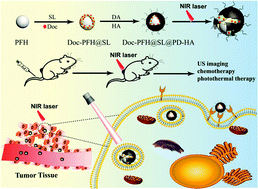Hyaluronic acid and polydopamine functionalized phase change nanoparticles for ultrasound imaging-guided photothermal-chemotherapy
Abstract
In this study, we successfully prepared polydopamine (PD) and hyaluronic acid (HA) coated liquid perfluorocarbon nanoparticles, which integrated the good photothermal conversion effect of PD, the ultrasound imaging properties of the liquid fluorocarbon and active tumor-targeting of HA. Liquid perfluorocarbon nanodroplets significantly improved in terms of their physical stability after being coated with PD and HA as the shell. Photothermal and ultrasound imaging experiments showed that PD could effectively convert near-infrared (NIR) laser energy into heat for photothermal therapy, which could induce a phase change of the liquid perfluorocarbon, thereby generating microbubbles, enhancing ultrasound imaging signals and promoting drug release. In vitro cellular experiments showed that HA on the surface of the nanoparticles could actively target 4T1 breast cancer cells by CD44 receptor-mediated endocytosis. Furthermore, the novel nanosystem has shown effective inhibition of tumor growth by synergistic photothermal-chemotherapy in tumor-bearing mice. In conclusion, the novel nanosystem we prepared in this study is expected to provide a new strategy for the diagnosis and treatment of cancer.



 Please wait while we load your content...
Please wait while we load your content...